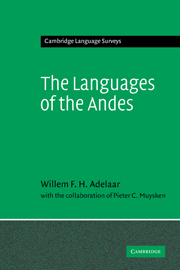Book contents
- Frontmatter
- Contents
- List of tables
- List of maps
- Preface
- Orthographic conventions
- List of abbreviations
- 1 Introduction
- 2 The Chibcha Sphere
- 3 The Inca Sphere
- 4 The languages of the eastern slopes
- 5 The Araucanian Sphere
- 6 The languages of Tierra del Fuego
- 7 The Spanish presence
- Appendix: Inventory of languages and language families of the Andean region
- References
- Author index
- Index of languages and ethnic groups
- Subject index
1 - Introduction
Published online by Cambridge University Press: 22 September 2009
- Frontmatter
- Contents
- List of tables
- List of maps
- Preface
- Orthographic conventions
- List of abbreviations
- 1 Introduction
- 2 The Chibcha Sphere
- 3 The Inca Sphere
- 4 The languages of the eastern slopes
- 5 The Araucanian Sphere
- 6 The languages of Tierra del Fuego
- 7 The Spanish presence
- Appendix: Inventory of languages and language families of the Andean region
- References
- Author index
- Index of languages and ethnic groups
- Subject index
Summary
In his book Visión histórica del Perú (A Historical Vision of Peru) the Peruvian historian Pablo Macera (1978) dates the beginning of human presence in the middle Andes at about 20,000 BC. The supposition of such an early human occupation, difficult to explain within the context of New World prehistory, is based on datings relating to excavations conducted by MacNeish at the highland site of Pikimachay of the Pacaicasa complex near Ayacucho (cf. MacNeish 1979). These datings are now considered very controversial (cf. Rick 1988). Although Macera himself recognises the uncertain character of the 20,000 BC date, its value is more than just scientific. It acquires the character of a fictitious date, needed to express the emotional feeling of timeless antiquity often associated with Andean culture and tradition, a feeling that is best put into words by the expression milenarismo andino (‘Andean millenarism’). It is not the cold evidence of radiocarbon datings, but the conscience of an immobile human society that clings fatalistically to age-old agricultural traditions perfectly adjusted to the formidable Andean landscape, that determines the view of the Andean intellectual until today. It is the view of a reality which has always been there, seemingly immune to the triviality of programmes aimed at modernisation and globalisation.
In the meantime, the antiquity of human settlement in the Andean region, indeed in all of South America, remains a matter of debate.
- Type
- Chapter
- Information
- The Languages of the Andes , pp. 1 - 45Publisher: Cambridge University PressPrint publication year: 2004

